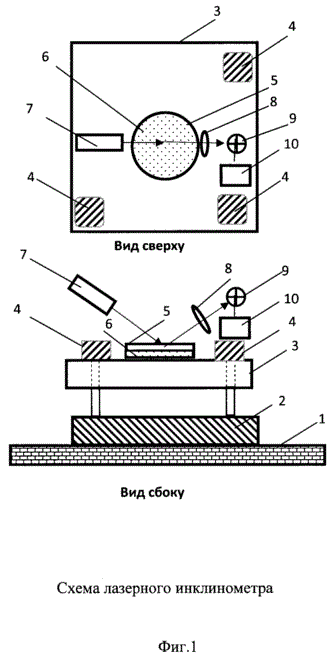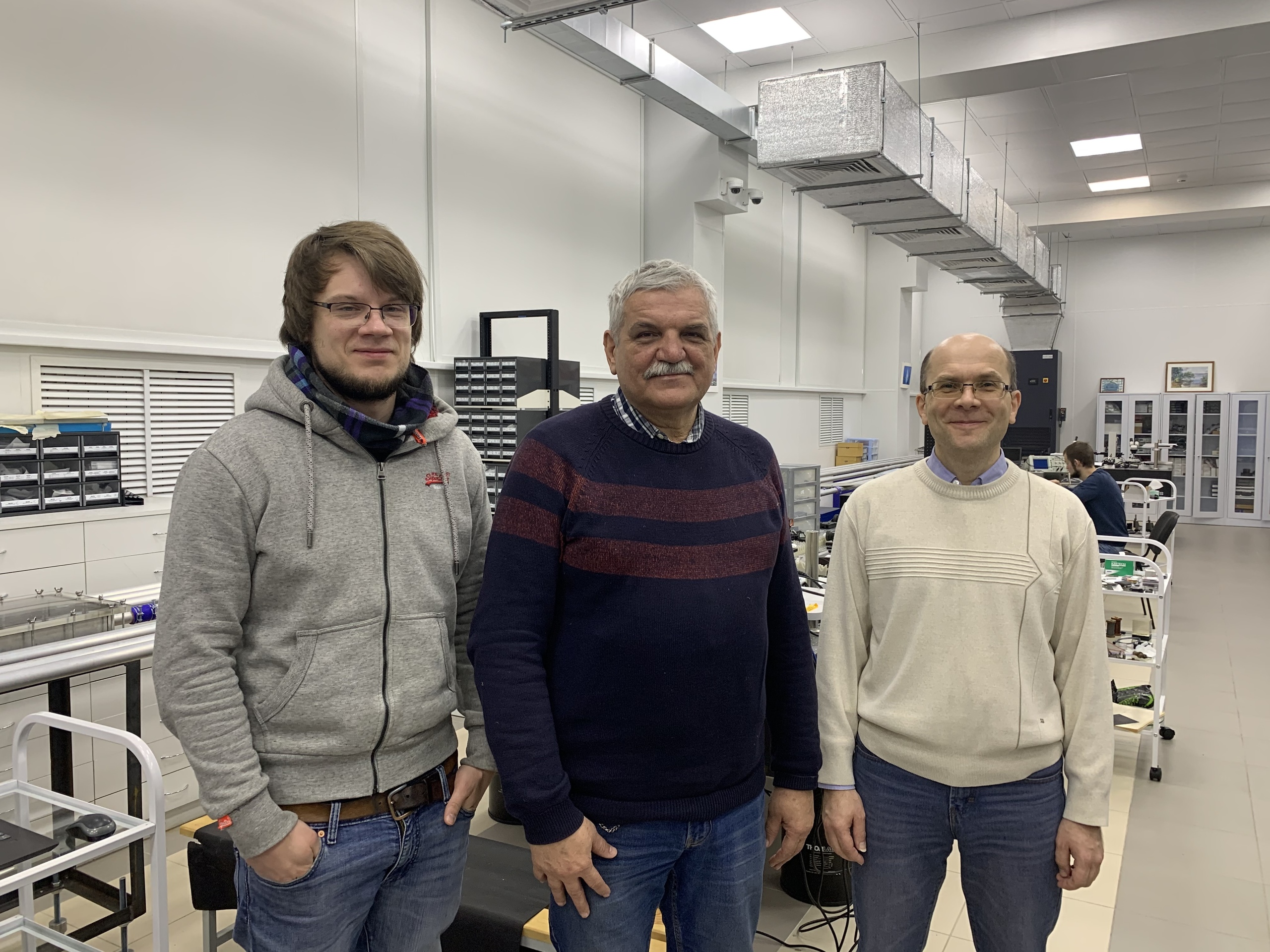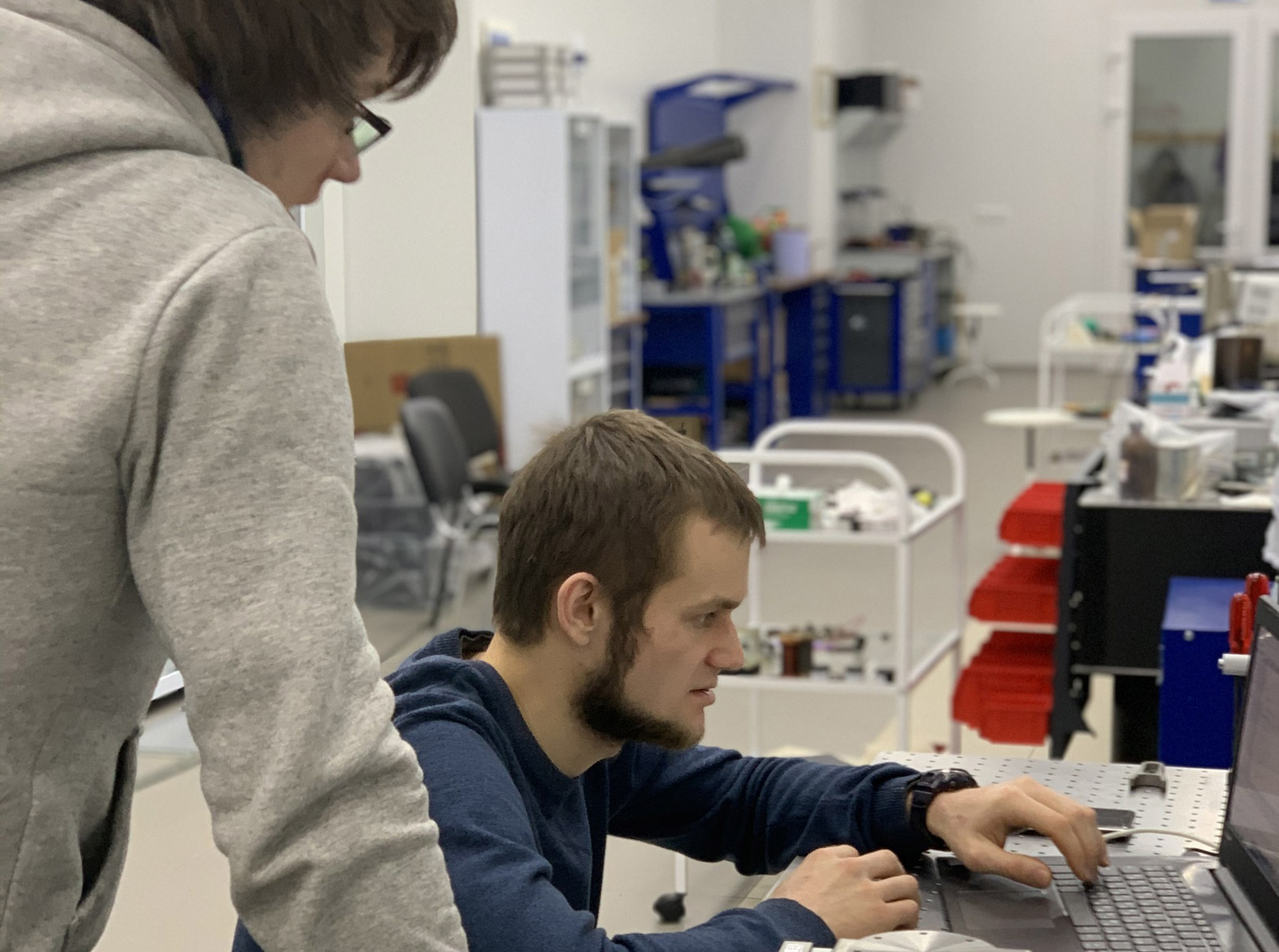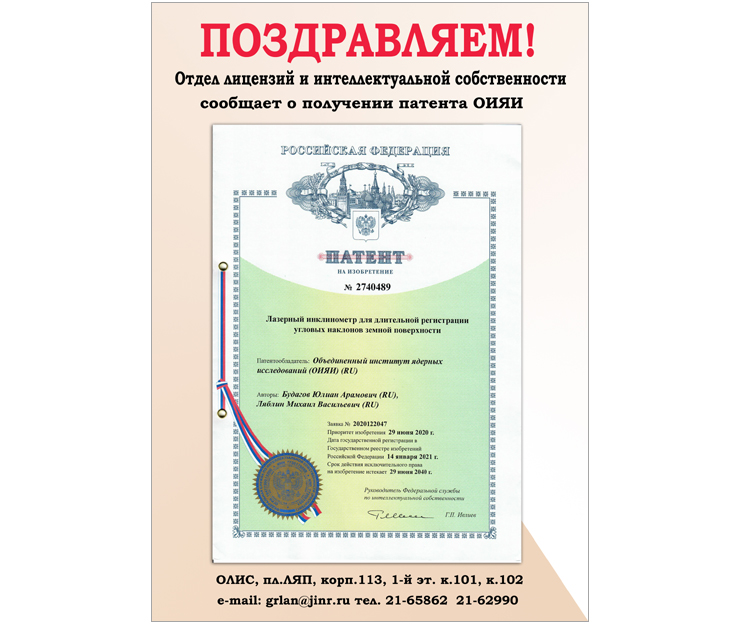Patent for laser inclinometer for long-term recording of earth surface angles
Patents, 02 February 2021
The Licensing and Intellectual Property Department of JINR announces that on 14 January 2021, the Joint Institute for Nuclear Research received a patent for the invention “Laser inclinometer for long-term recording of earth surface angles”. The authors of the work are Budagov Yulian Aramovich and Lyablin Mikhail Vasilevich.
JINR staff congratulates the authors on receiving the patent for their invention!
More details about the invention
 The invention refers to control and measuring technology. It can be used for precision measurements of Earth surface angular inclinations under thermal instability of the environment. The device comprises a stationary platform set on a rocky ground, a movable platform fixed on it with three identical positioners. A laser, a cuvette with a liquid, a focusing lens, a position-sensitive photodetector (PSPD) and a processing unit are placed on the movable platform. While the Earth surface is inclining, the laser beam reflected off the liquid changes its angular position, which is detected and analyzed by the PSPD and the processing unit. The change in ambient temperature entails unwanted laser beam shifts.
The invention refers to control and measuring technology. It can be used for precision measurements of Earth surface angular inclinations under thermal instability of the environment. The device comprises a stationary platform set on a rocky ground, a movable platform fixed on it with three identical positioners. A laser, a cuvette with a liquid, a focusing lens, a position-sensitive photodetector (PSPD) and a processing unit are placed on the movable platform. While the Earth surface is inclining, the laser beam reflected off the liquid changes its angular position, which is detected and analyzed by the PSPD and the processing unit. The change in ambient temperature entails unwanted laser beam shifts.
The following temperature resistive elements are used in the invention:
1. A lens which focuses the laser beam on the PSPD. After the laser beam passes the lens, its parallel shift does not impact the focus position. Also, the shift of the signal angular inclination of the beam is recorded. This excludes the impact of the parallel noise shift of the laser beam on the measurement results.
2. Three identical supporting positioners. They place the surface of the movable platform parallel to the surface of the stationary platform. And any temperature drift in the environment does not cause unwanted inclinations of the stationary platform. All this makes Earth surface angular inclination measurements temperature-independent.
The technical outcome is increase in temperature resistance of Earth surface angular inclination measurements, which permits using the device during considerable temperature drifts of the environment.
Please, pay attention
Before publishing the article on a scientific-technological development, JINR employees may address to the Licensing and Intellectual Property Department for making an application for a patent.
Address: DLNP site, bld.113, 1st floor, rooms 101-103
e-mail: grlan@jinr.ru
tel.: +7 (496) 216-58-62, 216-29-90.
About the inclinometer and work of the Metrological Laboratory of the DLNP JINR
The most anticipated breakthrough results in contemporary physics are obtained at mega-science facilities—huge colliders, arrays and telescopes—with scientists scrutinizing events and phenomena which are extremely hard to measure or to detect. Thus, coordinated functioning of all parts and components of scientific setups is really valuable as is also minimization of the ambient impact on the outcome.
The Sector of Laser Metrology of the DLNP Experimental Department of Multiple Hadronic Processes focuses on design and advancement of tools to back up scientists facing these modern challenges.
We have already written about one of these tools—the precision laser inclinometer, a singular device to measure an angle of inclination of an object in relation to the gravitational field of the Earth.
The design of this device got underway in 2010. In 2012, Yu. A. Budagov and M. V. Lyablin received RF Patent 2510488 “Device for measuring an angular inclination”. Over the last years, several prototype devices have been tested, and four devices were installed along the LHC beam trajectory (CERN). In 2018, one inclinometer was deployed in the tunnel of the Garni Geophysical Laboratory (Armenia). Since August 2019, one inclinometer is in use at the gravitational-wave antenna of VIRGO, a European experiment.
“Despite the second wave of the COVID-19 pandemic, improvement of the device and its preparation for small batch production are still going on at the DLNP Metrology Laboratory,” explained the Head of the Sector of Laser Metrology Mikhail Vasilevich Lyablin.
Scientists strive to make the inclinometer as compact as possible without impairing its performance qualities. It is the compact size that allows installing the device in gravitational-wave antennas. By summer 2021, ten compact inclinometers are to be manufactured.
The next ambitious goal of the Sector is to provide inclinometers for a new-generation gravitational-wave telescope, the so-called Einstein Telescope.
The future telescope will require 30 to 50 devices. Thanks to developments of the Sector of Laser Metrology, our Institute can get the chance to be involved into the future European mega-project.
That means, the inclinometer should be upgraded to be able to operate at liquid neon temperature, to which mirrors of the future telescope will be cooled in order to diminish thermal noise. This is a complicated and non-trivial challenge. And its solution should be worked out during this year.
 Ivan Bednyakov, Mikhail Lyablin and Aleksey Kuzkin
Ivan Bednyakov, Mikhail Lyablin and Aleksey Kuzkin
 Ivan Bednyakov and Yuli Klemeshov at the DLNP Metrology Laboratory
Ivan Bednyakov and Yuli Klemeshov at the DLNP Metrology Laboratory
(To be continued…)
DLNP Group of Scientific Communication
